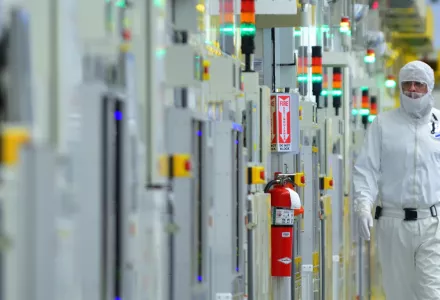
Download the Full Publication
Executive Summary
Problem Statement: In light of China’s pursuit of semiconductor independence, how can the US maintain industry leadership and supply chain resilience?
Background: Why is semiconductor manufacturing an economic and national security imperative?
Most Americans will encounter a dozen semiconductors within an hour of waking up in phones, coffeemakers, cars, dishwashers, traffic lights, and other devices that underlie modern life. In 2018, the US semiconductor industry employed 250,000+ people and generated over $200B in annual revenue. Semiconductors rank as the fourth-largest American export and provide the foundation for the global $2T electronics industry. Semiconductors enable our daily routines, power the US economy, and project American influence across the globe.
The semiconductor production lifecycle is incredibly complex, capital intensive, and geographically concentrated. While the US remains a global leader in the industry, American chip companies are increasingly dependent on foreign chokepoints in the supply chain. The US maintains an advantage in semiconductor design and end-stage mass production but has ceded almost all leading edge manufacturing competitiveness to suppliers abroad. Today, US chip design companies like Qualcomm, Nvidia, and Apple send the majority of their chip designs overseas for manufacturing. The US technology industry relies on one company, Taiwan Semiconductor Manufacturing Company (TSMC), for 90% of its advanced semiconductor manufacturing.
The US is increasingly reliant on leading-edge chips to power emerging technologies like Artificial Intelligence (AI). The most advanced manufacturers are now producing semiconductors at the 5nm node. For perspective, a human hair is around 75,000nm. As AI is integrated into business operations and national security technology, the US must maintain a steady supply of advanced chips.
“The [Huawei] ban was China’s Sputnik moment for semiconductors”
– Haomiao Huang, Kleiner Perkins
Risks: Will China achieve semiconductor independence?
Semiconductor independence is a cornerstone of “Made in China 2025,” China’s 10-year industrial plan to transform its economy from the ‘world's factory’ for cheap, low-quality products into a leader in high-tech manufacturing and services. China has used a combination of state subsidies, industry consolidation, and zero-sum tactics to promote the development of its semiconductor industry. China’s investment is unparalleled: state, provincial, and municipal leaders have allocated $118B in planned investment in semiconductor technology over five years.
China will likely remain partially dependent on foreign suppliers for high-end chips after 2030. As Moore’s Law slows down, however, experts across the semiconductor industry, finance, academia, and government agree that it is only a matter of time before China catches up to Western leaders.
The industry also faces near-term risks from China’s strategy. China’s zero-sum tactics like talent poaching and IP theft overwhelmingly target Taiwan, the most important country for US semiconductor manufacturing. An estimated one-third of the island’s engineers have been recruited through China’s “Thousand Talents Program” alone, and TSMC faces increasing pressure to support either US or Chinese national interests.
“Whether our relationship with China as a country gets better or not, it’s... a fait accompli that China wants to be independent of US technology and will do everything they can to make that happen... it will only be a matter of time for at least some of the products they purchase today”
- Mark Edelstone, Morgan Stanley
As China pursues semiconductor independence, the US cannot afford to maintain the status quo. In the short term, the US may become increasingly dependent on Chinese companies for low-end hardware components. In the long term, China could leverage market leadership to restrict US companies’ access to critical components in the event of a military or political conflict. Additionally, as automation and artificial intelligence are integrated into defense systems, the US must maintain a reliable source of verified trusted chips. China’s AI accelerators pose a cybersecurity and supply chain risk if the national security community cannot secure domestic alternatives.
Recommendations: What untapped opportunities should the US prioritize?
Without decisive action, the US risks moving from a position of leadership to one of dependence. We recommend three core areas of investment, policy support, and partnership to guide the National Security Commission on AI’s recommendations to Congress:
1. Invest in Leading Edge Domestic Manufacturing:
We suggest revitalizing one of two potential channels: GlobalFoundries’ advanced chip manufacturing program or Intel’s third-party foundry operations. In 2018, GlobalFoundries shuttered its 7nm program to focus on the growing low-end chip market, and Intel scaled back foundry operations after struggling to compete with TSMC on reliability and cost. With an infusion of R&D, GlobalFoundries may be able to achieve advanced manufacturing, or Intel may be able to resume third-party manufacturing at competitive costs and yields.
Congress can provide financial and regulatory support, such as setting up an import processing zone next to Intel fab to incentivize investment in domestic advanced chip packaging. As detailed in the implementation section, the total financial commitment is estimated to be $20B annually. This could come from a public-private partnership model, as domestic US design houses may be incentivized to co-fund a competitive US alternative to TSMC and Samsung.
2. Double Down on Support for US Strengths:
The US has a competitive advantage in research, design, and innovation. We recommend a spectrum of policy changes that would increase support and reduce barriers that exist today. These reflect the most pressing needs early-stage semiconductor founders, investors, and engineers articulated in first-hand interviews. These recommendations include:
-
Consolidate funding for semiconductor research under one oversight authority, such as DARPA (DOD) or the Office of Science Basic Research Needs (DOE), to increase the size and impact of federal research grants.
-
Develop a scholarship program for students who pursue graduate study in target fields, like electrical engineering or photonics, with a pathway to work in the US on long-term research or early-stage development.
-
Provide tax incentives for institutions that build and maintain leading semiconductor test facilities. Tax credits for small-scale semiconductor facilities in universities and accelerators could help defray prohibitively high upfront capital costs.
-
Streamline visa programs for employees at semiconductor startups. Semiconductor startups rely on foreign researchers for talent and struggle to secure visas for top engineers.
-
De-risk early-stage semiconductor investment for the private sector. Expand eligibility for non-dilutive capital, such as removing the 51% US ownership requirement for AFWERX5 grants, reducing compliance costs for US Treasury- backed low-interest loans, and purchasing small batch orders from hardware startups.
3. Drive International Collaboration:
The current US approach relies on methods that are often defensive, counterproductive, and unilateral. We recommend a more proactive and collaborative approach to leverage common interests and increase pressure on China to reduce its use of illicit tactics. These recommendations include:
-
Explore a Western coalition for national semiconductor champions. US and EU companies have a security and business interest in reducing sovereign risk in the supply chain, and GlobalFoundries and Intel are better prepared to compete with TSMC and Samsung than any European company. Airbus serves as a useful model for cross-border collaboration.
-
Strengthen export controls on advanced manufacturing equipment and technology. ASML (Netherlands) is the sole supplier of EUV lithography, a technologically- complex manufacturing process that uses ultraviolet light to etch patterns onto silicon at the atomic level. Tokyo Electron (Japan) produces almost 90% of key chemical materials like advanced EUV coaters and developers. An international export control agreement would significantly restrict China’s advanced manufacturing development and allows for greater precision than current industrial control policies.
-
Support Taiwan’s “Southbound” economic policy. Taiwanese politicians and entrepreneurs aim to position the island as a Southbound country with cultural and economic ties to neighbors like Vietnam. This strategy helps preserve Taiwanese manufacturing independence and decrease China’s influence in Taiwan.
“We have to bring economics back into the national security conversation”
- Michael J. Rogers, former U.S. Representative and Chairman of the Permanent Select Committee on Intelligence
Because the Commission reports to Congress, these recommendations encompass policy options available to Congress rather than the Commission itself. Some of these policy prescriptions can be achieved through legislation alone. Others, however, will require multiple years of development and demand a coalition of technology leaders, market professionals, and international partners. The most critical need, restoring advanced domestic manufacturing, demands immediate action. The US cannot wait until 2025 to evaluate whether Beijing has realized its economic goals. China has already demonstrated progress against “Made in China 2025,” and is rapidly deploying technologies like 5G and facial recognition that blur the divide between the physical and digital worlds. In a future in which every car, toothbrush, and weapon has a sensor, it becomes an economic and national security imperative to invest in semiconductor resilience today.
Bo Julie and Raina can be reached at bojulie@alumni.harvard.edu and raina@alumni.harvard.edu.
Crowley, Bo Julie and Raina Johnson. “Made in the USA: Revitalizing the Domestic Semiconductor Industry.” Belfer Center for Science and International Affairs, Harvard Kennedy School, July 2020







